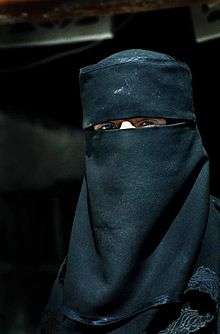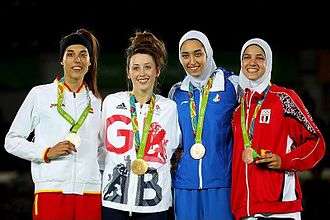Hijab
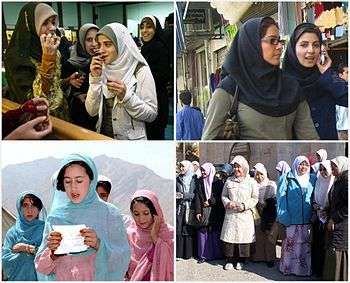
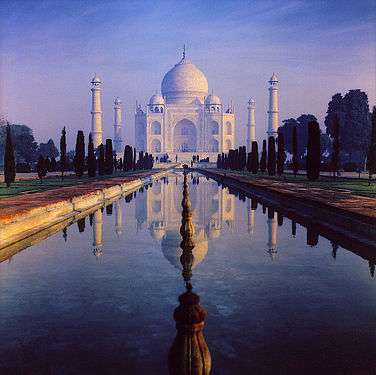 |
| Part of a series on |
| Islamic culture |
|---|
| Architecture |
| Art |
| Dress |
| Holidays |
| Literature |
| Music |
| Theatre |
|
A hijab (/hɪˈdʒɑːb/, /hɪˈdʒæb/, /ˈhɪ.dʒæb/ or /hɛˈdʒɑːb/;[1][2][3][4] Arabic: حجاب ḥijāb, pronounced [ħiˈdʒæːb] or [ħiˈɡæːb]) is a veil traditionally worn by Muslim women in the presence of adult males outside of their immediate family, which usually covers the head and chest. The term can further refer to any head, face, or body covering worn by Muslim women that conforms to a certain standard of modesty. Hijab can also be used to refer to the seclusion of women from men in the public sphere, or it may denote a metaphysical dimension, for example referring to "the veil which separates man or the world from God".[5]
Most often, it is worn by Muslim women as a symbol of modesty and privacy. According to the Encyclopedia of Islam and Muslim World, modesty in the Quran concerns both men's and women's "gaze, gait, garments, and genitalia."[6] The Qur'an admonishes Muslim women to dress modestly.[7] Some Islamic legal systems define this type of modest clothing as covering everything except the face, elbows, and knees.[5][8] These guidelines are found in texts of hadith and fiqh developed after the revelation of the Qur'an but, according to some, are derived from the verses (ayahs) referencing hijab in the Qur'an.[6] Some believe that the Qur'an itself does not mandate that women wear hijab.[9][10]
In the Qur'an the term hijab refers to a partition or curtain in the literal or metaphorical sense. The verse where it is used literally is commonly understood to refer to the curtain separating visitors to Muhammad's house from his wives' lodgings. This had led some to argue that the mandate of the Qur'an to wear hijab applied to the wives of Muhammad, and not women generally.[11][12]
In recent times, wearing hijab in public has been required by law in Iran, Saudi Arabia and the Indonesian province of Aceh. Other countries have passed laws banning some or all types of hijab in public or in certain types of locales. Women in different parts of the world have also experienced unofficial pressure to wear or not wear hijab in general, or in its certain forms, including physical attacks.
In Islamic scripture
Quran
The Quran instructs both Muslim men and women to dress in a modest way, but there is disagreement on how these instructions should be interpreted. The verses relating to dress use the terms khimār (head cover) and jilbāb (a dress or cloak) rather than ḥijāb.[13]
The clearest verse on the requirement of modest dress is surah 24:30–31, telling women to draw their khimār over their bosoms.[14][15]
And say to the believing women that they should lower their gaze and guard their modesty; that they should not display their beauty and ornaments except what (must ordinarily) appear thereof; that they should draw their khimār over their breasts and not display their beauty except to their husband, their fathers, their husband's fathers, their sons, their husbands' sons, their brothers or their brothers' sons, or their sisters' sons, or their (Muslim) women, or the slaves whom their right hands possess, or male servants free of physical needs, or small children who have no sense of the shame of sex; and that they should not strike their feet in order to draw attention to their hidden ornaments.
In Surah 33:59 Muhammad is commanded to ask his family members and other Muslim women to wear outer garments when they go out, so that they are not harassed:[15]
Those who harass believing men and believing women undeservedly, bear (on themselves) a calumny and a grievous sin. O Prophet! Enjoin your wives, your daughters, and the wives of true believers that they should cast their outer garments over their persons (when abroad): That is most convenient, that they may be distinguished and not be harassed.
The word ḥijāb in the Quran refers not to women's clothing, but rather a spatial partition or curtain.[13] Sometimes its use is literal, as in the verse which refers to the screen that separated Muhammad's wives from the visitors to his house (33:53), while in other cases the word denotes separation between deity and mortals (42:51), wrongdoers and righteous (7:46, 41:5), believers and unbelievers (17:45), and light from darkness (38:32).[13]
Hadith
.jpg)
The Arabic word jilbab is translated as "cloak" in the following passage. Contemporary Salafis insist that the jilbab (which is worn over the Kimaar and covers from the head to the toe) worn today is the same garment mentioned in the Qur'an and the hadith; other translators have chosen to use less specific terms:
- Narrated Anas ibn Malik: "I know (about) the Hijab (the order of veiling of women) more than anybody else. Ubay ibn Ka'b used to ask me about it. Allah's Apostle became the bridegroom of Zaynab bint Jahsh whom he married at Medina. After the sun had risen high in the sky, the Prophet invited the people to a meal. Allah's Apostle remained sitting and some people remained sitting with him after the other guests had left. Then Allah's Apostle got up and went away, and I too, followed him till he reached the door of 'Aisha's room. Then he thought that the people must have left the place by then, so he returned and I also returned with him. Behold, the people were still sitting at their places. So he went back again for the second time, and I went along with him too. When we reached the door of 'Aisha's room, he returned and I also returned with him to see that the people had left. Thereupon the Prophet hung a curtain between me and him and the Verse regarding the order for (veiling of women) Hijab was revealed." Sahih al-Bukhari, 7:65:375, Sahih Muslim, 8:3334
- Narrated Umm Salama Hind bint Abi Umayya, Ummul Mu'minin: "When the verse 'That they should cast their outer garments over their persons' was revealed, the women of Ansar came out as if they had crows hanging down over their heads by wearing outer garments." 32:4090. Abū Dawud classed this hadith as authentic.
- Narrated Safiya bint Shaiba: "Aisha used to say: 'When (the Verse): "They should draw their veils (Khumur) over their necks and bosoms (juyyub)," was revealed, (the ladies) cut their waist sheets at the edges and covered their faces with the cut pieces.'" Sahih al-Bukhari, 6:60:282, 32:4091.
Dress code required by hijab
Traditionalist views
Traditionally, Muslims have recognized many different forms of clothing as satisfying the demands of hijab.[16] Debate focused on how much of the male or female body should be covered. Different scholars adopted different interpretations of the original texts.
Detailed scholarly attention has focused on prescribing female dress in conformity with hijab. The four major Sunni schools of thought (Hanafi, Shafi'i, Maliki and Hanbali) hold that the entire body of the woman, except her face and hands – though a few clerics say face, hands – must be covered during prayer and in public settings (see Awrah). There are those who allow the feet to be uncovered as well as the hands and face.[17][18]
It is recommended that women wear clothing that is not form fitting to the body: either modest forms of western clothing (long shirts and skirts), or the more traditional jilbāb, a high-necked, loose robe that covers the arms and legs. A khimār or shaylah, a scarf or cowl that covers all but the face, is also worn in many different styles. Some scholars encourage covering the face, while some follow the opinion that it is not obligatory to cover the face and the hands but only mustahab (Highly recommended). Other scholars oppose face covering, particularly in the West, where the woman may draw more attention as a result. These garments are very different in cut from most of the traditional forms of ħijāb, and they are worn worldwide by Muslims.
.jpg)
Many Muslim scholars believe that it is a basic requirement of Islamic law that women keep their hair and bodies covered in the presence of people of the opposite sex other than close family members (those close enough to be forbidden to marry—see mahram). These include the Iraqi Shia Marja' (Grand Ayatollah) Ali al-Sistani;[19] the Sunni Permanent Committee for Islamic Research and Issuing Fatwas in Saudi Arabia;[20] and others.[21] According to some interpretations, these requirements extend to non-Muslim women as well. Some believers go so far as to specify exactly which areas of the body must be covered. In some cases, this is everything but the eyes, but most require that women cover everything but the face and hands. In nearly all Muslim cultures, young girls are not required to wear a ħijāb. There is not a single agreed age when a woman should begin wearing a ħijāb—but in many Muslim cultures, puberty is the dividing line.
In private, and in the presence of close relatives (mahrams), rules on dress relax. However, in the presence of the husband, most scholars stress the importance of mutual freedom and pleasure of the husband and wife.[22]
It has become tradition that Muslims in general, and Salafis in particular, believe the Qur'an demands women wear the garments known today as jilbāb and khumūr (the khumūr must be worn underneath the jilbāb). However, Qur'an translators and commentators translate the Arabic into English words with a general meaning, such as veils, head-coverings and shawls.[23] Ghamidi argues that verses [Quran 24:30] teach etiquette for male and female interactions, where khumūr is mentioned in reference to the clothing of Arab women in the 7th century, but there is no command to actually wear them in any specific way. Hence he considers head-covering a preferable practice but not a directive of the sharia (law).[24]
Alternative views

Some Muslims take a relativist approach to hijab. They believe that the commandment to maintain modesty must be interpreted with regard to the surrounding society. What is considered modest or daring in one society might not be considered so in another. It is important, they say, for believers to wear clothing that communicates modesty and reserve.[25]
Along with scriptural arguments, Leila Ahmed argues that head covering should not be compulsory in Islam because the veil predates the revelation of the Qur'an. Head-covering was introduced into Arabia long before Muhammad, primarily through Arab contacts with Syria and Iran, where the hijab was a sign of social status. After all, only a woman who need not work in the fields could afford to remain secluded and veiled.[11][26]
Ahmed argues for a more liberal approach to hijab. Among her arguments is that while some Qur'anic verses enjoin women in general to "draw their Jilbabs (overgarment or cloak) around them to be recognized as believers and so that no harm will come to them"[Quran 33:58–59] and "guard their private parts ... and drape down khimar over their breasts [when in the presence of unrelated men]",[Quran 24:31] they urge modesty. The word khimar refers to a piece of cloth that covers the head, or headscarf.[27] While the term "hijab" was originally anything that was used to conceal,[28] it became used to refer to concealing garments worn by women outside the house, specifically the headscarf or khimar.[29]
Other verses do mention separation of men and women.
Abide still in your homes and make not a dazzling display like that of the former times of ignorance.
And when ye ask of them [the wives of the Prophet] anything, ask it of them from behind a curtain.
According to at least three authors (Karen Armstrong, Reza Aslan and Leila Ahmed), the stipulations of the hijab were originally meant only for Muhammad's wives, and were intended to maintain their inviolability. This was because Muhammad conducted all religious and civic affairs in the mosque adjacent to his home:
People were constantly coming in and out of this compound at all hours of the day. When delegations from other tribes came to speak with Prophet Muhammad, they would set up their tents for days at a time inside the open courtyard, just a few feet away from the apartments in which Prophet Muhammad's wives slept. And new emigrants who arrived in Yatrib would often stay within the mosque's walls until they could find suitable homes.[11]
According to Ahmed:
By instituting seclusion Prophet Muhammad was creating a distance between his wives and this thronging community on their doorstep.[12]
They argue that the term darabat al-hijab ("taking the veil") was used synonymously and interchangeably with "becoming Prophet Muhammad's wife", and that during Muhammad's life, no other Muslim woman wore the hijab. Aslan suggests that Muslim women started to wear the hijab to emulate Muhammad's wives, who are revered as "Mothers of the Believers" in Islam,[11] and states "there was no tradition of veiling until around 627 C.E." in the Muslim community.[11][12]
Another interpretation differing from the traditional states that a veil is not compulsory in front of blind men and men lacking physical desire.[30][31][32]
Contemporary practice
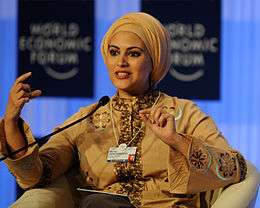
The styles and practices of hijab vary widely across the world.
An opinion poll conducted in 2014 by The University of Michigan’s Institute for Social Research asked residents of seven Muslim-majority countries (Egypt, Iraq, Lebanon, Tunisia, Turkey, Pakistan, and Saudi Arabia) which style of women's dress they considered to be most appropriate in public.[33] The survey found that the headscarf (in its tightly- or loosely-fitting form) was chosen by the majority of respondents in Egypt, Iraq, Tunisia and Turkey.[33] In Saudi Arabia 63% gave preference to the niqab face veil; in Pakistan the niqab, the full-length chador robe and the headscarf, received about a third of the votes each; while in Lebanon half of the respondents in the sample (which included Christians and Druze) opted for no head covering at all.[33][34]
.jpg)
The survey found "no significant difference" in the preferences between surveyed men and women, except in Pakistan, where more men favored conservative women's dress.[34] However, women more strongly support women's right to choose how to dress.[34] People with university education are less conservative in their choice than those without one, and more supportive of women's right to decide their dress style, except in Saudi Arabia.[34]
Some fashion-conscious women have been turning to non-traditional forms of hijab such as turbans.[35][36] While some regard turbans as a proper head cover, others argue that it cannot be considered a proper Islamic veil if it leaves the neck exposed.[35]
According to a Pew Research Center survey, among the roughly 1 million Muslim women living in the U.S., 43% regularly wear headscarves, while about a half do not cover their hair.[37] In another Pew Research Center poll (2011), 36% of Muslim American women reported wearing hijab whenever they were in public, with an additional 24% saying they wear it most or some of the time, while 40% said they never wore the headcover.[38]

In Iran, where wearing the hijab is legally required, many women push the boundaries of the state-mandated dress code, risking a fine or a spell in detention.[39] The Iranian president Hassan Rouhani had vowed to rein in the morality police and their presence on the streets has decreased since he took office, but the powerful conservative forces in the country have resisted his efforts, and the dress codes are still being enforced, especially during the summer months.[40]
In Turkey the hijab was formerly banned in private and state universities and schools. The ban applied not to the scarf wrapped around the neck, traditionally worn by Anatolian peasant women, but to the head covering pinned neatly at the sides, called türban in Turkey, which has been adopted by a growing number of educated urban women since the 1980s. As of mid-2000s, over 60% of Turkish women covered their head outside home, though only 11% wore a türban.[41][42][43][44] The ban was lifted from universities in 2011, from government buildings in 2013,[45] and from schools in 2014.[46]
Burqa and niqab
There are several types of veils which cover the face in part or in full.
The burqa (also spelled burka) is a garment that covers the entire body, including the face.[47] It is commonly associated with the Afghan chadri, whose face-veiling portion is typically a piece of netting that obscures the eyes but allows the wearer to see out.
The niqab is a term which is often incorrectly used interchangeably with burqa.[47] It properly refers to a garment that covers a woman's upper body and face, except for her eyes.[47] It is particularly associated with the style traditionally worn in the Arabian Peninsula, where the veil is attached by one side and covers the face only below the eyes, thereby allowing the eyes to be seen.
Only a minority of Islamic scholars believe that covering the face is mandatory, and the use of niqab beyond its traditional geographic strongholds has been a subject of political controversy.[48][49]
In a 2014 survey of men and women in seven Muslim-majority countries, the Afghan burqa was the preferred form of woman's dress for 11% of respondents in Saudi Arabia, 4% in Iraq, 3% in Pakistan, 2% in Lebanon, and 1% or less in Egypt, Tunisia, and Turkey.[33] The niqab face veil was the preferred option for 63% of respondents in Saudi Arabia, 32% in Pakistan, 9% in Egypt, 8% in Iraq, and 2% or less in Lebanon, Tunisia, and Turkey.[33]
History
Pre-Islamic veiling practices
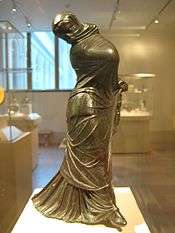
Veiling did not originate with the advent of Islam. Statuettes depicting veiled priestesses precede all three Abrahamic religions (Christianity, Judaism, and Islam), dating back as far as 2500 BCE.[50] Elite women in ancient Mesopotamia and in the Byzantine, Greek, and Persian empires wore the veil as a sign of respectability and high status.[51] In ancient Mesopotamia, Assyria had explicit sumptuary laws detailing which women must veil and which women must not, depending upon the woman's class, rank, and occupation in society.[51] Female slaves and prostitutes were forbidden to veil and faced harsh penalties if they did so.[13] Veiling was thus not only a marker of aristocratic rank, but also served to "differentiate between 'respectable' women and those who were publicly available".[13][51]
Strict seclusion and the veiling of matrons were also customary in ancient Greece. Between 550 and 323 B.C.E, prior to Christianity, respectable women in classical Greek society were expected to seclude themselves and wear clothing that concealed them from the eyes of strange men.[52]
.jpg)
It is not clear whether the Hebrew Bible contains prescriptions with regard to veiling, but rabbinic literature presents it as a question of modesty (tzinut).[53] Modesty became an important rabbinic virtue in the early Roman period, and it may have been intended to distinguish Jewish women from their non-Jewish counterparts in the Greco-Roman and later in the Babylonian society.[53] According to rabbinical precepts, married Jewish women have to cover their hair, although the surviving representations of veiled Jewish women may reflect general Roman customs rather than particular Jewish practices.[53] According to Fadwa El Guindi, at the inception of Christianity, Jewish women were veiling their head and face.[13]
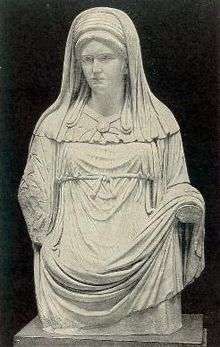
There is archeological evidence suggesting that early Christian women in Rome covered their heads.[53] Writings of Tertullian indicate that a number of different customs of dress were associated with different cults to which early Christians belonged around 200 CE.[53] The best known early Christian view on veiling is the passage in 1 Corinithians (11:4-7), which states that "every woman who prays or prophesies with her head uncovered dishonors her head".[53] This view may have been influenced by Roman pagan customs, such as the head covering worn by the priestessess of Vesta (Vestal Virgins), rather than Jewish practices.[53] In turn, the rigid norms pertaining to veiling and seclusion of women found in Christian Byzantine literature have been influenced by ancient Persian traditions, and there is evidence to suggest that they differed significantly from actual practice.[54]
Intermixing of populations resulted in a convergence of the cultural practices of Greek, Persian, and Mesopotamian empires and the Semitic peoples of the Middle East.[13] Veiling and seclusion of women appear to have established themselves among Jews and Christians, before spreading to urban Arabs of the upper classes and eventually among the urban masses.[13] In the rural areas it was common to cover the hair, but not the face.[13]
Leila Ahmed argues that "Whatever the cultural source or sources, a fierce misogyny was a distinct ingredient of Mediterranean and eventually Christian thought in the centuries immediately preceding the rise of Islam."[55] Ahmed interprets veiling and segregation of sexes as an expression of a misogynistic view of shamefulness of sex which focused most intensely on shamefulness of the female body and danger of seeing it exposed.[55]
During Muhammad's lifetime
Available evidence suggests that veiling was not introduced into Arabia by Muhammad, but already existed there, particularly in the towns, although it was probably not as widespread as in the neighboring countries such as Syria and Palestine.[56] Similarly to the practice among Greeks, Romans, Jews, and Assyrians, its use was associated with high social status.[56] In the early Islamic texts, term hijab does not distinguish between veiling and seclusion, and can mean either "veil" or "curtain".[57] The only verses in the Qur'an that specifically reference women’s clothing are those promoting modesty, instructing women to guard their private parts and throw a scarf over their heads to their bosoms in the presence of men.[58] The contemporary understanding of the hijab dates back to Hadith when the "verse of the hijab" descended upon the community in 627 CE.[59] Now documented in Sura 33:53, the verse states, "And when you ask [his wives] for something, ask them from behind a partition. That is purer for your hearts and their hearts".[60] This verse, however, was not addressed to women in general, but exclusively to Muhammad's wives. As Muhammad's influence increased, he entertained more and more visitors in the mosque, which was then his home. Often, these visitors stayed the night only feet away from his wives' apartments. It is commonly understood that this verse was intended to protect his wives from these strangers.[61] During Muhammad's lifetime the term for donning the veil, darabat al-hijab, was used interchangeably with "being Muhammad's wife".[56]
Later pre-modern history

The practice of veiling was borrowed from the elites of the Byzantine and Persian empires, where it was a symbol of respectability and high social status, during the Arab conquests of those empires.[62] Reza Aslan argues that "The veil was neither compulsory nor widely adopted until generations after Muhammad's death, when a large body of male scriptural and legal scholars began using their religious and political authority to regain the dominance they had lost in society as a result of the Prophet's egalitarian reforms".[61]
Because Islam identified with the monotheistic religions of the conquered empires, the practice was adopted as an appropriate expression of Qur'anic ideals regarding modesty and piety.[63] Veiling gradually spread to upper-class Arab women, and eventually it became widespread among Muslim women in cities throughout the Middle East. Veiling of Arab Muslim women became especially pervasive under Ottoman rule as a mark of rank and exclusive lifestyle, and Istanbul of the 17th century witnessed differentiated dress styles that reflected geographical and occupational identities.[13] Women in rural areas were much slower to adopt veiling because the garments interfered with their work in the fields.[64] Since wearing a veil was impractical for working women, "a veiled woman silently announced that her husband was rich enough to keep her idle."[65]
By the 19th century, upper-class urban Muslim and Christian women in Egypt wore a garment which included a head cover and a burqa (muslin cloth that covered the lower nose and the mouth).[13] The name of this garment, harabah, derives from early Christian and Judaic religious vocabulary, which may indicate the origins of the garment itself.[13]
Modern history
.jpg)
Western clothing largely dominated in Muslim countries the 1960s and 1970s.,.[66][67] For example, in Pakistan, Afghanistan and Iran, many liberal women wore short skirts, flower printed hippie dresses, flared trousers,[68] and went out in public without the hijab.[69][70] This changed following the Soviet invasion of Afghanistan, military dictatorship in Pakistan, and Iranian revolution of 1979, when traditional conservative attire including the abaya, jilbab and niqab made a comeback.[71][72] There were demonstrations in Iran in March 1979, after the hijab law was brought in, decreeing that women in Iran would have to wear scarves to leave the house.[73]
The late-twentieth century saw a resurgence of the hijab in Egypt after a long period of decline as a result of the westernization of Egypt. Already in the mid-1970s some college aged Muslim men and women began a movement meant to reunite and rededicate themselves to the Islamic faith.[74][75] This movement was named the Sahwah,[76] or awakening, and sparked a period of heightened religiosity that began to be reflected in the dress coe.[74] The uniform adopted by the young female pioneers of this movement was named al-Islāmī (Islamic dress) and was made up of an "al-jilbāb—an unfitted, long-sleeved, ankle-length gown in austere solid colors and thick opaque fabric—and al-khimār, a head cover resembling a nun's wimple that covers the hair low to the forehead, comes under the chin to conceal the neck, and falls down over the chest and back".[74] In addition to the basic garments that were mostly universal within the movement, additional measures of modesty could be taken depending on how conservative the followers wished to be. Some women choose to also utilize a face covering (al-niqāb) that leaves only eye slits for sight, as well as both gloves and socks in order to reveal no visible skin.
Soon this movement expanded outside of the youth realm and became a more widespread Muslim practice. Women viewed this way of dress as a way to both publicly announce their religious beliefs as well as a way to simultaneously reject western influences of dress and culture that were prevalent at the time. Despite many criticisms of the practice of hijab being oppressive and detrimental to women’s equality,[75] many Muslim women view the way of dress to be a positive thing. It is seen as a way to avoid harassment and unwanted sexual advances in public and works to desexualize women in the public sphere in order to instead allow them to enjoy equal rights of complete legal, economic, and political status. This modesty was not only demonstrated by their chosen way of dress but also by their serious demeanor which worked to show their dedication to modesty and Islamic beliefs.[74]
Controversy erupted over the practice. Many people, both men and women from backgrounds of both Islamic and non-Islamic faith questioned the hijab and what it stood for in terms of women and their rights. There was questioning of whether in practice the hijab was truly a female choice or if women were being coerced or pressured into wearing it.[74] Many instances, such as a period of forced veiling for women in Iran, brought these issues to the forefront and generated great debate from both scholars and everyday people.
As the awakening movement gained momentum, its goals matured and shifted from promoting modesty and Islamic identity towards more of a political stance in terms of retaining support for Islamic nationalism and to resist western influences. Today the hijab means many different things for different people. For Islamic women who choose to wear the hijab it allows them to retain their modesty, morals and freedom of choice.[75] They choose to cover because they believe it is liberating and allows them to avoid harassment. Many people (both Muslim and non-Muslim) are against the wearing of the hijab and argue that the hijab causes issues with gender relations, works to silence and repress women both physically and metaphorically, and have many other problems with the practice. This difference in opinions has generated a plethora of discussion on the subject, both emotional and academic, which continues today.
Ever since September 11, 2001, the discussion and discourse on the hijab has intensified. Many nations have attempted to put restrictions on the hijab, which has led to a new wave of rebellion by women who instead turn to covering and wearing the hijab in even greater numbers.[75][78]
Compulsion and pressure
Some governments encourage and even oblige women to wear the hijab, while others have banned it in at least some public settings. In many parts of the world women also experience informal pressure for or against wearing hijab, including physical attacks.
Legal enforcement

The Kingdom of Saudi Arabia requires Muslim women to cover their hair and all women have to wear a full-body garment.[79] Saudi women commonly wear the traditional abaya robe, while foreigners sometimes opt for a long coat.[79] These regulations are enforced by the religious police and vigilantes.[79] In 2002 the Saudi religious police were accused by Saudi and international press of hindering the rescue of schoolgirls from a fire because they were not wearing hijab, which resulted in 15 deaths.[80]
Iran went from banning all types of veils in 1936 to restoring original dress code between 1980 and 1984.[81] Practical decisions started with the Iranian Cultural Revolution in April 1980, when it was decided that women in government offices and educational institutions would observe the veil.[81] The 1983 penal code prescribed punishment of 74 lashes for women appearing in public without Islamic hijab (hijab shar'ee), leaving the definition of proper hijab ambiguous.[82][83] The same period witnessed tensions around the definition of proper hijab, which sometimes resulted in vigilante harrassment of women who were perceived to wear improper clothing.[81][82] The government felt obliged to address this situation, and in 1984 Tehran’s public prosecutor announced that a stricter dress-code should observed in public establishments, while clothing in other places should correspond to standards observed by the majority of the people.[81] A new regulation issued in 1988 by the Ministry of the Interior based on the 1983 law further specified what constituted violations of hijab.[84] Iran's current penal code stipulates a fine or 10 days to two months in prison as punishment for failure to observe hijab in public, without specifying its form.[85][86] The dress code has been subject of alternating periods of relatively strict and relaxed enforcement over the years, with many women pushing its boundaries, and its compulsory aspect has been a point of contention between conservatives and the current president Hassan Rouhani.[85][87][88] In governmental and religious institutions, the dress code requires khimar-type headscarf and overcoat, while in other public places women commonly wear a loosely tied headscarf (rousari). Iranian government endorses and officially promotes stricter types of veiling, praising it by invoking both Islamic religious principles and pre-Islamic Iranian culture.[89]
The Indonesian Aceh province requires Muslim women to wear hijab in public.[90] The central Indonesian government granted Aceh's religious leaders the right to impose the Sharia in 2001 in a deal aiming to put an end to the separatist movement in the province.[90]
Legal bans
The tradition of veiling hair in Iranian culture has ancient pre-Islamic origins,[91] but the widespread custom was forcibly ended by Reza Shah's regime in 1936, as he claimed hijab to be incompatible with his modernizing ambitions and ordered "unveiling" act or Kashf-e hijab. The police arrested women who wore the veil and would forcibly remove it, and these policies outraged the Shi'a clerics, and ordinary men and women, to whom appearing in public without their cover was tantamount to nakedness. Many women refused to leave the house out of fear of being assaulted by Reza Shah's police.[92] In 1941 the compulsory element in the policy of unveiling was abandoned.
Turkey, Tunisia, and Tajikistan are Muslim-majority countries where the law prohibits or recently prohibited the wearing of hijab in government buildings, schools, and universities. In Tunisia, women were banned from wearing hijab in state offices in 1981 and in the 1980s and 1990s more restrictions were put in place.[93] In 2008 the Turkish government attempted to lift a ban on Muslim headscarves at universities, but were overturned by the country's Constitutional Court.[94] In December 2010, however, the Turkish government ended the headscarf ban in universities, government buildings and schools.[95]
On March 15, 2004, France passed a law banning "symbols or clothes through which students conspicuously display their religious affiliation" in public primary schools, middle schools, and secondary schools. In the Belgian city of Maaseik, Niqāb has been banned since 2006.[96] On July 13, 2010, France's lower house of parliament overwhelmingly approved a bill that would ban wearing the Islamic full veil in public. There were 335 votes for the bill and one against in the 557-seat National Assembly.
In 2016, more than 20 French towns banned the use of the burqini, a style of swimwear intended to accord with rules of hijab.[97][98][99] Dozens of women were subsequently issued fines, with some tickets citing not wearing "an outfit respecting good morals and secularism", and some were verbally attacked by bystanders when they were confronted by the police.[97][100][101][102] Enforcement of the ban also hit beachgoers wearing a wide range of modest attire besides the burqini.[97][102] Media reported that in one case the police forced a woman to remove part of her clothing on a beach in Nice.[100][101][102] The Nice mayor's office denied that she was forced to do so and the mayor condemned what he called the "unacceptable provocation" of wearing such clothes in the aftermath of the Nice terrorist attack.[97][102]
Unofficial pressure to wear hijab
Successful informal coercion of women by sectors of society to wear hijab has been reported in Gaza where Mujama' al-Islami, the predecessor of Hamas, reportedly used "a mixture of consent and coercion" to "'restore' hijab" on urban educated women in Gaza in the late 1970s and 1980s.[103]
Similar behaviour was displayed by Hamas itself during the First Intifada in Palestine. Though a relatively small movement at this time, Hamas exploited the political vacuum left by perceived failures in strategy by the Palestinian factions to call for a "return" to Islam as a path to success, a campaign that focused on the role of women.[104] Hamas campaigned for the wearing of the hijab alongside other measures, including insisting women stay at home, segregation from men and the promotion of polygamy. In the course of this campaign women who chose not to wear the hijab were verbally and physically harassed, with the result that the hijab was being worn "just to avoid problems on the streets".[105]
Wearing of the hijab was enforced by the Taliban regime in Afghanistan. The Taliban required women to cover not only their head but their face as well, because "the face of a woman is a source of corruption" for men not related to them.[106]
In Srinagar, the capital of Indian-administered Kashmir, a previously unknown militant group calling itself Lashkar-e-Jabbar claimed responsibility for a series of acid attacks on women who did not wear the burqa in 2001, threatening to punish women who do not adhere to their vision of Islamic dress. Women of Kashmir, most of whom are not fully veiled, defied the warning, and the attacks were condemned by prominent militant and separatist groups of the region.[107][108]
In 2006, radicals in Gaza have been accused of attacking or threatening to attack the faces of women in an effort to intimidate them from wearing allegedly immodest dress.[109]
In 2014 the Islamic State of Iraq and the Levant was reported to have executed several women for not wearing niqab with gloves.[110]
Unofficial pressure against wearing hijab
After the initial 1936 ban on hijab in Iran, the rules of dress code were relaxed, and after Reza Shah's abdication in 1941 the compulsory element in the policy of unveiling was abandoned. According to Mohammad Reza Shah Pahlavi, between 1941 and 1979, wearing hijab was no longer offensive, but still considered it to be a real hindrance to climbing the social ladder, a badge of backwardness and a marker of class. A headscarf, let alone the chador, prejudiced the chances of advancement in work and society not only of working women but also of men, who were increasingly expected to appear with their wives at social functions.
In recent years, women wearing hijab have been subject of verbal and physical attacks in Western countries, particularly following terrorist attacks.[111][112][113][114] Louis A. Cainkar writes that the data suggest that women in hijab rather than men are the predominant target of anti-Muslim attacks not because they are more easily identifiable as Muslims, but because they are seen to represent a threat to the local moral order that the attackers are seeking to defend.[112] Some women stop wearing hijab out of fear or following perceived pressure from their acquaintances, but many refuse to stop wearing it out of religious conviction even when they are urged to do so for self-protection.[112]
Kazakhstan has no official ban on wearing hijab, but those who wear it have reported that authorities use a number of tactics to discriminate against them.[115]
In 2015 authorities in Uzbekistan organized a "deveiling" campaign in the capital city Tashkent, during which women wearing hijab were detained and taken to a police station. Those who agreed to remove their hijab were released "after a conversation", while those who refused were transferred to the counterterrorism department and given a lecture. Their husbands or fathers were then summoned to convince the women to obey the police. This followed an earlier campaign in the Fergana Valley.[116]
In 2016 in Kyrgyzstan the government has sponsored street banners aiming to dissuade women from wearing the hijab.[117]
World Hijab Day
World Hijab Day is an annual event that takes place on February 1. The first World Hijab Day was celebrated in 2013. Founded by Nazma Khan, it is a worldwide event that encourages Muslim and non-Muslim women to wear the hijab to experience the life of a Hijabi woman.[118]
See also
- Covering variants
- Abaya
- Burqa
- Burqini
- Chador
- Cowl
- Ghoonghat
- Niqāb
- Paranja
- Purdah
- Sari
- Tagelmust (worn by men)
- Tudong
- Yashmak
- Non-Muslim
Notes
- ↑ "Definition of hijab in Oxford Dictionaries (British & World English)". Oxforddictionaries.com. Retrieved 2013-04-20.
- ↑ "Hijab – Definition and More from the Free Merriam-Webster Dictionary". Merriam-webster.com. 2012-08-31. Retrieved 2013-04-20.
- ↑ "Hijab noun – definition in British English Dictionary & Thesaurus – Cambridge Dictionary Online". Dictionary.cambridge.org. 2013-04-16. Retrieved 2013-04-20.
- ↑ "Definition of hijab". Collins English Dictionary. Retrieved 2013-04-20.
- 1 2 Glasse, Cyril, The New Encyclopedia of Islam, Altamira Press, 2001, p.179-180
- 1 2 Encyclopedia of Islam and the Muslim World (2003), p. 721, New York: Macmillan Reference USA
- ↑ Martin et al. (2003), Encyclopedia of Islam & the Muslim World, Macmillan Reference, ISBN 978-0028656038
- ↑ Fisher, Mary Pat. Living Religions. New Jersey: Pearson Education, 2008.
- ↑ Irfi.org
- ↑ Moroccoworldnews.com
- 1 2 3 4 5 Aslan, Reza, No God but God, Random House, (2005), p.65–6
- 1 2 3 Women and Gender in Islas: Historical Roots of a Modern Debate – Leila Ahmed – Google Boeken. Books.google.com. 1992. ISBN 9780300055832. Retrieved 2013-04-20.
- 1 2 3 4 5 6 7 8 9 10 11 12 El Guindi, Fadwa; Sherifa Zahur (2009). "Hijab". The Oxford Encyclopedia of the Islamic World. Retrieved August 22, 2016. (subscription required (help)).
- ↑ Evidence in the Qur'an for Covering Women's Hair, IslamOnline.
- 1 2 Hameed, Shahul. "Is Hijab a Qur’anic Commandment?," IslamOnline.net. October 9, 2003.
- ↑ Kausar Khan, "Veiled Feminism: The dating scene looks a little different from behind the veil," Current (Winter 2007): 14-15.
- ↑ The Hanbali school of thought also views the face as the awrah, though this view is rejected by Hanafis, Malikis and Shafi'is.
- ↑ Hsu, Shiu-Sian. "Modesty." Encyclopaedia of the Qur'an. Ed. Jane McAuliffe. Vol. 3. Leiden, The Netherlands: Brill Academic Publishers, 2003. 403-405. 6 vols.
- ↑ al-Sistani, Ali. "Question & Answer » Hijab (Islamic Dress)". The Official Website of the Office of His Eminence Al-Sayyid Ali Al-Husseini Al-Sistani. Retrieved 9 January 2016.
- ↑ "Fatwas of the Permanent Committee: Women covering their faces and hands". General Presidency of Scholarly Research and Ifta'. Kingdom of Saudi Arabia. Retrieved 9 January 2016.
- ↑ Contributing Writer. "What Is the Islamic Rule of Wearing a Veil? [URL pending Wikipedia editor whitelisting]". Opposing Views.
- ↑ Heba G. Kotb M.D., Sexuality in Islam, PhD Thesis, Maimonides University, 2004
- ↑ See collection of Qur'an translations, compared verse by verse
- ↑ Javed Ahmed Ghamidi, Mizan, Chapter: The Social Law of Islam, Al-Mawrid.
- ↑ Syed, Ibrahim B. (2001). "Women in Islam: Hijab".
- ↑ Ahmed, Leyla (1992). Women and Gender in Islam: Historical Roots of a Modern Debate. New Haven: Yale University Press. ISBN 0300055838.
- ↑ V.A. Mohamad Ashrof. Islam and gender justice:. Gyan Books, 2005. p. 130. Retrieved 8 April 2011.
- ↑ Asma Afsaruddin; A. H. Mathias Zahniser. Humanism, culture, and language in the Near East. Eisenbrauns, 1997. p. 87. Retrieved 8 April 2011.
- ↑ Asma Afsaruddin; A. H. Mathias Zahniser. Humanism, culture, and language in the Near East. Eisenbrauns, 1997. p. 95. Retrieved 8 April 2011.
- ↑ "Is it ok to take off the kimar and niqab in front of a blind man?". Islamqa.info. Retrieved 2013-04-20.
- ↑ Women revealing their adornment to men who lack physical desire retrieved 25 June 2012
- ↑ Queer Spiritual Spaces: Sexuality and Sacred Places – Page 89, Kath Browne, Sally Munt, Andrew K. T. Yip - 2010
- 1 2 3 4 5 "Female Muslim Dress Survey Reveals Wide Range Of Preferences On Hijab, Burqa, Niqab, And More". Huffington Post. Jan 23, 2014.
- 1 2 3 4 RICH MORIN (Jan 14, 2014). "Q&A with author of U. Mich. study on preferred dress for women in Muslim countries". Pew Research Center.
- 1 2 Shounaz Meky (Oct 9, 2014). "Under wraps: Style savvy Muslim women turn to turbans". Al Arabiya.
- ↑ Yasmin Nouh (May 11, 2016). "The Beautiful Reasons Why These Women Love Wearing A Hijab". The Huffington Post.
- ↑ "Lifting The Veil: Muslim Women Explain Their Choice". NPR. April 21, 2011.
- ↑ "Muslim Americans: No Signs of Growth in Alienation or Support for Extremism; Section 2: Religious Beliefs and Practices". Pew Research Center. Aug 30, 2011.
- ↑ "Playing cat and mouse with Iran′s morality police". Qantara.de. Retrieved Aug 23, 2016.
- ↑ Yara Elmjouie (June 19, 2014). "Iran's morality police: patrolling the streets by stealth". Tehran Bureau/The Guardian.
- ↑ Rainsford, Sarah (November 7, 2006). "Headscarf issue challenges Turkey". BBC News.
- ↑ Rainsford, Sarah (2007-10-02). "Women condemn Turkey constitution". BBC News. Retrieved 2008-08-04.
- ↑ Jonathan Head (December 31, 2010). "Quiet end to Turkey's college headscarf ban". BBC News.
- ↑ Clark-Flory, Tracy (2007-04-23). "Head scarves to topple secular Turkey?". Salon. Retrieved 2008-08-04.
- ↑ "Turkey Lifts Longtime Ban on Head Scarves in State Offices". NY Times. 8 October 2013. Retrieved 1 February 2014.
- ↑ "Turkey-lifts-ban-on-headscarves-at-high-schools". news24.com/. Retrieved 3 November 2014.
- 1 2 3 "From hijab to burqa - a guide to Muslim headwear". Channel 4 News. Oct 24, 2013.
- ↑ "Niqab". BBC. Retrieved Aug 23, 2016.
- ↑ "The Islamic veil across Europe". BBC. July 1, 2014.
- ↑ Kahf, Mohja (2008). From Royal Body the Robe was Removed: The Blessings of the Veil and the Trauma of Forced Unveiling in the Middle East. University of California Press. p. 27.
- 1 2 3 Ahmed, Leila (1992). Women and Gender in Islam. New Haven: Yale University Press. p. 15.
- ↑ Ahmed, Leila (1992). Women and Gender in Islam. New Haven: Yale University Press. pp. 27–28.
- 1 2 3 4 5 6 7 Richard Freund. "The Veiling of Women in Judaism, Christianity and Islam. A Guide to the Exhibition" (PDF). University of Hartford. Retrieved Aug 22, 2016.
- ↑ Ahmed, Leila (1992). Women and Gender in Islam. New Haven: Yale University Press. pp. 26–28.
- 1 2 Ahmed, Leila (1992). Women and Gender in Islam. New Haven: Yale University Press. p. 35.
- 1 2 3 Ahmed, Leila (1992). Women and Gender in Islam. New Haven: Yale University Press. pp. 55–56.
- ↑ Ahmed, Leila (1992). Women and Gender in Islam. New Haven: Yale University Press. pp. 53–54.
- ↑ >Ahmed, Leila (1992). Women and Gender in Islam. New Haven: Yale University Press. p. 55.
- ↑ Aslan, Reza (2005). No God but God. Random House. p. 65. ISBN 1-4000-6213-6.
- ↑ "Surat Al-'Ahzab". Retrieved December 1, 2012.
- 1 2 Aslan, Reza (2005). No God but God. Random House. p. 66. ISBN 1-4000-6213-6.
- ↑ John L. Esposito, ed. (2014). "Hijab". The Oxford Dictionary of Islam. Oxford: Oxford University Press. (subscription required (help)).
- ↑ Ahmed, Leila (1992). Women and Gender in Islam. New Haven: Yale University Press. p. 36.
- ↑ Esposito, John (1991). Islam: The Straight Path (3 ed.). Oxford University Press. p. 99.
- ↑ Bloom (2002), p.47
- ↑ ["A Quiet Revolution: The Veil's Resurgence, from the Middle East to America", Leila Ahmed (Yale University Press, 2014)] ]
- ↑ "Retro Middle East: The rise and fall of the miniskirt ", albawaba.com, August 18th, 2013, accessed 23 October 2016
- ↑ Bhutto's Pakistan
- ↑ Iranian womens fashion
- ↑ Afghanistan before the war
- ↑ Pakistan's swinging 70s
- ↑ Iran before the revolution
- ↑ theguardian.com, 3 September 2015, accessed 23 October 2016
- 1 2 3 4 5 El Guindi, Fadwa; Zuhur, Sherifa. "Ḥijāb". The Oxford Encyclopedia of the Islamic World. Retrieved 11 October 2012.
- 1 2 3 4 Bullock, Katherine (2000). "Challenging Medial Representations of the Veil". The American Journal of Islamic Social Sciences. 17 (3): 22–53.
- ↑ Elsaie, Adel. "Dr.". United States of Islam.
- ↑ Patrick Johnston (Aug 19, 2016). "Kimia Alizadeh Zenoorin Becomes The First Iranian Woman To Win An Olympic Medal". Reuters/Huffington Post.
- ↑ Winter, Bronwyn (2006). "The Great Hijab Coverup". Off Our Backs; a women's newsjournal. 36 (3): 38–40. JSTOR 20838653.
- 1 2 3 "Saudi Arabia's dress code for women". The Economist. Jan 28, 2015.
- ↑ "Saudi police 'stopped' fire rescue". BBC. March 15, 2002.
- 1 2 3 4 Ramezani, Reza (spring 2007). Hijab dar Iran az Enqelab-e Eslami ta payan Jang-e Tahmili [Hijab in Iran from the Islamic Revolution to the end of the Imposed war] (Persian), Faslnamah-e Takhassusi-ye Banuvan-e Shi’ah [Quarterly Journal of Shiite Women] 11, Qom: Muassasah-e Shi’ah Shinasi, pp. 251-300, ISSN 1735-4730
- 1 2 Elizabeth M. Bucar (2011). Creative Conformity: The Feminist Politics of U.S. Catholic and Iranian Shi'i Women. Georgetown University Press. p. 118.
- ↑ "قانون مجازات اسلامی (Islamic Penal Code), see ماده 102 (article 102)". Islamic Parliament Research Center. Retrieved Oct 12, 2016.
- ↑ Elizabeth M. Bucar (2011). Creative Conformity: The Feminist Politics of U.S. Catholic and Iranian Shi'i Women. Georgetown University Press. p. 118.
exposure of head, hair, arms or legs, use of makeup, sheer or tight clothing, and clothes with foreign words or pictures
- 1 2 Sanja Kelly, Julia Breslin (2010). Women's Rights in the Middle East and North Africa: Progress Amid Resistance. Rowman & Littlefield Publishers. p. 126.
- ↑ Behnoosh Payvar (2016). Space, Culture, and the Youth in Iran: Observing Norm Creation Processes at the Artists’ House. Springer. p. 73.
- ↑ BBC Monitoring (Apr 22, 2016). "Who are Islamic 'morality police'?". BBC.
- ↑ "Iranians worry as morality police go undercover". AP/CBS News. Apr 27, 2016.
- ↑ Strategies for promotion of chastity (Persian), the official website of Iranian Majlis (04/05/1384 AP, available online)
- 1 2 Jewel Topsfield (April 7, 2016). "Ban on outdoor music concerts in West Aceh due to Sharia law". The Sydney Morning Herald.
- ↑ CLOTHING ii. In the Median and Achaemenid periods at Encyclopædia Iranica
- ↑ El-Guindi, Fadwa, Veil: Modesty, Privacy, and Resistance, Berg, 1999
- ↑ "Tunisia's Hijab Ban Unconstitutional". 11 October 2007. Retrieved 2013-04-20.
- ↑ "Turkey's AKP discusses hijab ruling". Al Jazeera. 6 June 2008.
- ↑ "Quiet end to Turkey's college headscarf ban". BBC News. 31 December 2010.
- ↑ Mardell, Mark. "Dutch MPs to decide on burqa ban", BBC News, January 16, 2006. Accessed June 6, 2008.
- 1 2 3 4 ALISSA J. RUBIN (Aug 24, 2016). "French 'Burkini' Bans Provoke Backlash as Armed Police Confront Beachgoers". New York Times.
- ↑ "Cannes bans burkinis over suspected link to radical Islamism". BBC News. 12 August 2016. Retrieved 12 August 2016.
- ↑ "Nice joins growing list of French towns to ban burqini". The Local.fr. 19 August 2016. Retrieved 22 August 2016.
- 1 2 Harry Cockburn (Aug 24, 2016). "Burkini ban: Armed police force woman to remove her clothing on Nice beach". The Independent.
- 1 2 Ben Quinn (Aug 23, 2016). "French police make woman remove clothing on Nice beach following burkini ban". The Guardian.
- 1 2 3 4 Angelique Chrisafis (Aug 24, 2016). "French burkini ban row escalates after clothing incident at Nice beach". The Guardian.
- ↑ "Women and the Hijab in the Intifada", Rema Hammami Middle East Report, May–August 1990
- ↑ Rubenberg, C., Palestinian Women: Patriarchy and Resistance in the West Bank (USA, 2001) p.230
- ↑ Rubenberg, C., Palestinian Women: Patriarchy and Resistance in the West Bank (USA, 2001) p.231
- ↑ M. J. Gohari (2000). The Taliban: Ascent to Power. Oxford: Oxford University Press, pp. 108-110.
- ↑ Popham, Peter (in Delhi) (30 August 2001). "Kashmir women face threat of acid attacks from militants". The Independent. Retrieved 20 April 2013.
- ↑ "Kashmir women face acid attacks". BBC News. 10 August 2001. Retrieved 20 April 2013.
- ↑ In 2006, a group in Gaza calling itself "Just Swords of Islam" is reported to have claimed it threw acid at the face of a young woman who was dressed "immodestly", and warned other women in Gaza that they must wear hijab. December 2, 2006 Gaza women warned of immodesty
- ↑ Syrian Women Face Whipping and Execution for Breaking Sharia Dress Code
- ↑ Basia Spalek (2013). Basia Spalek, ed. Muslim women's safety talk and their experience of victimisation. Islam, Crime and Criminal Justice. Routledge. pp. 63–64.
- 1 2 3 Louis A. Cainkar (2009). Homeland Insecurity: The Arab American and Muslim American Experience After 9/11. Russell Sage Foundation. pp. 244–245.
- ↑ Kirk Semple (Nov 25, 2015). "'I'm Frightened': After Attacks in Paris, New York Muslims Cope With a Backlash". New York Times.
- ↑ MICHELLE MARK (Dec 23, 2015). "Muslim Hate Crimes Soar In UK: After Paris Attacks, Women Wearing Hijab Targeted By Young White Men". International Business Times.
- ↑ Farangis Najibullah (March 20, 2011). "Hijab Now A Hot Topic In Kazakhstan". Radio Free Europe/Radio Liberty.
- ↑ Bruce Pannier,Farruh Yusupov (June 14, 2015). "'Deveiling' Drive Moves To Uzbekistan's Capital". Radio Free Europe/Radio Liberty.
- ↑ BBC Trending (13 August 2016). "Kyrgyzstan president: 'Women in mini skirts don't become suicide bombers'". BBC.
- ↑ "World Hijab Day". Worldhijabday.com.
References
- Ahmed, Leila (1992). Women and Gender in Islam: Historical Roots of a Modern Debate. New Haven: Yale University Press. ISBN 0-300-05583-8.
- Aslan, Reza, No god but God: The Origins, Evolution, and Future of Islam, Random House, 2005
- Bloom, Jonathan; Blair, Sheila (2002). Islam: A Thousand Years of Faith and Power. Yale University Press. ISBN 0-300-09422-1.
- El Guindi, Fadwa (1999). Veil: Modesty, Privacy, and Resistance. Oxford: Berg. ISBN 1-85973-929-6.
- Elver, Hilal. The Headscarf Controversy: Secularism and Freedom of Religion (Oxford University Press; 2012); 265 pages; Criticizes policies that serve to exclude pious Muslim women from the public sphere in Turkey, France, Germany, and the United States.
- Esposito, John (2003). The Oxford Dictionary of Islam. Oxford University Press. ISBN 0-19-512558-4.
External links
| Wikiquote has quotations related to: Hijab |
| Wikinews has previous reports related to this article: | |
![]() Media related to Hijab at Wikimedia Commons
Media related to Hijab at Wikimedia Commons
- BBC drawings of different types of Islamic women's clothing
- ReOrienting the Veil, an educational website about Islamic veiling

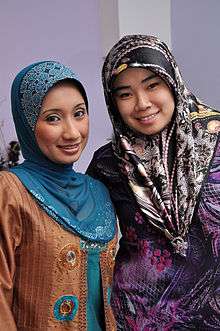
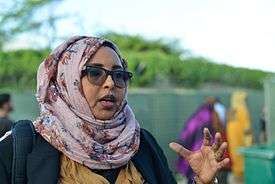
.jpg)
_Brig._Gen._Khatool_Mohammadzai%2C_center%2C_the_director_for_women's_affairs_and_the_deputy_director_for_the_education_and_physical_training_within_the_ANA%2C_poses_with_a_group_of_120220-A-WI966-673.jpg)
_-_Isfahan_-_Central_Iran_-_01_(7433558348).jpg)
